Huawei h12-831 practice test
HCIP-Datacom-Advanced Routing & Switching Technology
Question 1
On the OSPF network shown in the figure, the cost values of links are marked, and OSPF IP FRR is
enabled on R1. Which of the following statements are true?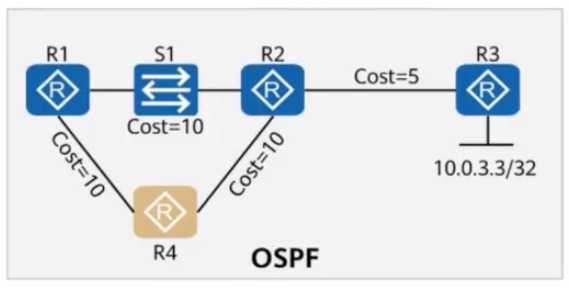
- A. No backup path can be established between R1 and 10.0.3.3/32.
- B. If SI is powered off, R1 directly uses the backup path to forward packets to R3.
- C. If BFD (with default detection parameters) is enabled on the entire network and the link between R2 and SI is disconnected, R1 can quickly detect the OSPF adjacency fault.
- D. If the link between R1 and SI is disconnected, R1 directly uses the backup path to forward packets to R3.
Answer:
B, C, D
Question 2
On the OSPF network shown in the figure, the cost values of links are marked, and OSPF IP FRR is
enabled on R1. Which of the following statements is false?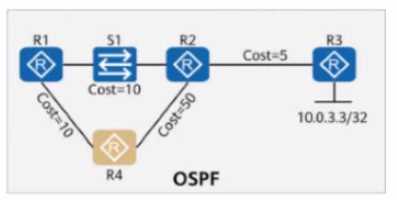
- A. If the link between R1 and SI is disconnected, Rl recalculates the optimal path to R3 and performs path switching instantly.
- B. If the link between R2 and SI is disconnected, R1 recalculates the optimal path to R3 and performs path switching instantly.
- C. If the link between R1 and SI is disconnected, R1 directly uses the backup path to forward packets to R3 because FRR is enabled on R1.
- D. If the link between R1 and SI is disconnected and you check neighbor information on R1, the neighbor relationship between R1 and R2 will instantly display Down.
Answer:
A
Question 3
On a stable network that requires fast route convergence, you can change the value of the interval at
which OSPF LSAs are updated to 0 so that topology or route changes can be immediately advertised
on the network through LSAs, which speeds up route convergence.
- A. TRUE
- B. FALSE
Answer:
A
Question 4
On the ISIS network shown in the figure, R1 imports a default route using the default-route-advertise
always level-1 command. In this case, R3 can learn this default route through IS-IS.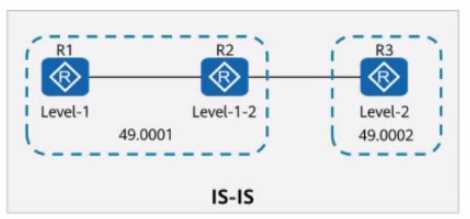
- A. TRUE
- B. FALSE
Answer:
B
Question 5
On the network shown in the figure, EBGP peer relationships are established between neighboring
routers through directly connected interfaces. The router ID of each router is 10.0.X.X, and the AS
number is 6500X, where X is the number of the router. Both Rl and R4 have static routes to
192.168.1.0/24, which are imported to BGP through the import-route command. R3 is configured
with the peer y.y.y.y as-path-filter 1 import command for all peers. Which of the following sets of
commands enables R3 to select the route with the longest AS_Path to 192.168.1.0/24?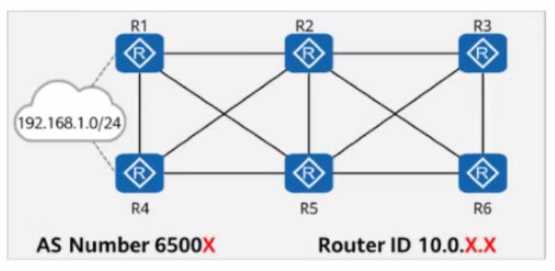
- A. jp as-path-filter 1 deny .*6500 ip as-path-filter 1 permit .*
- B. ip as-path-filter 1 deny A65002 ip as-path-filter 1 deny A65005 ip as-path-filter 1 permit .*
- C. ip as-path-filter 1 permit .* ip as-path-filter 1 deny 65001s ip as-path-filter 1 deny A65005
- D. ip as-path-filter 1 deny 65001s ip as-path-filter 1 permit .*
Answer:
A
Question 6
On the network shown in the figure, EBGP peer relationships are established between neighboring
routers through directly connected interfaces. The AS number is 6500X, where X is the number of the
router. Both Rl and R4 have static routes to 192.168.1.0/24, which are imported to BGP through the
import-route command. By default, in the routing table of R3, which of the following is the AS_Path
attribute carried in the route to 192.168.1.0/24?
- A. 65002, 65001
- B. 65002, 65005, 65004
- C. 65006, 65005, 65004
- D. 65006, 65005, 65004, 65001
Answer:
C
Question 7
On the network shown in the figure, IS-IS runs on Rl, R2, R4, and R5, and the area ID is 49.0001. IS-IS
runs on R3 and R6, and the area ID is 49.0002. In AS 65000, Ri, R3, R4, and R6 each establish IBGP
peer relationships with R2 and R5. R2 and R5 are RRs, and Rl, R4, R3, and R6 are clients. The IBGP
peer relationships are established using LoopbackO. The IP address of LoopbackO on each router is
10.0.X.X/32, and the router ID is 10.0.X.X, where X is the number of the router. Rl and R4 import the
external route 192.168.1.0/24 to BGP through the import-route command, and R3 and R6 import the
external route 192.168.2.0/24 to BGP through the import-route command. Which of the following
statements are true?
- A. For 192.168.2.0/24, R2 preferentially selects the BGP route received from R3.
- B. For 192.168.1.0/24, R3 preferentially selects the BGP route received from R2.
- C. For 192.168.2.0/24, R5 preferentially selects the BGP route received from R3.
- D. For 192.168.1.0/24, R6 preferentially selects the BGP route received from R2.
Answer:
A, B, C, D
Question 8
BGP allows you to use the filter-policy acl-number import command to filter received routes. The
value of ad-number ranges from 2000 to 3999.
- A. TRUE
- B. FALSE
Answer:
A
Question 9
To protect a device against the attacks of forged BGP messages, you can configure GTSM to check
whether the TTL value in the IP message header is within the specified range. If the peer x.x.x.x valid-
ttl-hops 100 command is configured on a device, the valid TTL value range of the detected message is
[155, 255].
- A. TRUE
- B. FALSE
Answer:
B
Question 10
On the network shown in the figure, IS-IS runs on R1, R2, R4, and R5, and the area ID is 49.0001. IS-IS
runs on R3 and R6, and the area ID is 49.0002. The import-route isis level-2 into level-1 command is
configured on R2 and R5. In AS 65000, R1, R3, R4, and R6 each establish IBGP peer relationships with
R2 and R5. R2 and R5 are RRs, and R1, R4, R3, and R6 are clients. The IBGP peer relationships are
established using Loopback0. The IP address of Loopback0 on each router is 10.0.X.X/32, and the
router ID is 10.0.X.X, where X is the number of the router. R1 and R4 import the external route
192.168.1.0/24 to BGP through the import-route command, and R3 and R6 import the external route
192.168.2.0/24 to BGP through the import-route command. Which of the following statements are
true?
- A. The routing table of R4 contains two equal-cost default routes.
- B. The route 192.168.2.0/24 in the routing table of R4 has two different outbound interfaces.
- C. The routing table of R1 contains the route 192.168.2.0/24.
- D. The routing table of R1 contains two equal-cost default routes.
Answer:
B, C
Question 11
The figure shows the Router-LSA generated by a router. Which of the following statements are true
based on the LSA?
- A. The router is an ASBR.
- B. At least one interface on the router belongs to area 0.
- C. The router is an ABR.
- D. At least one interface on the router belongs to a stub area.
Answer:
B, C
Question 12
On the OSPFv3 network shown in the figure, OSPFv3 is enabled on the interfaces connecting R1, R2,
and R3. The router ID of each router is 10.0.X.X, where X is the number of the router. If you check
detailed information about an LSA on R3, the command output shows that the LSA is generated by
R2 and describes the IPv6 prefix address associated with the Router-LSA.
- A. TRUE
- B. FALSE
Answer:
A
Question 13
R1 and R2 use directly connected interfaces to establish an EBGP peer relationship. R1 imports 2000::
1/128 to BGR By default, which of the following is the next hop of the route from R2 to 2000:: 1/128?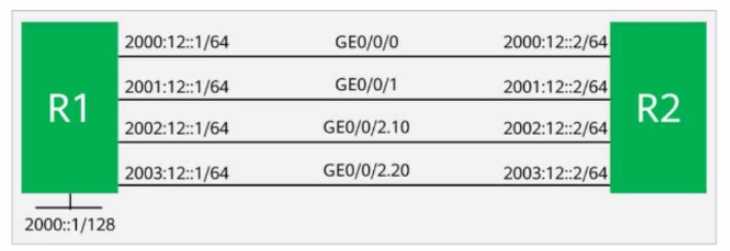
- A. 2002: 12:: 1
- B. 2001:12.1
- C. 2003:12::1
- D. 2000:12::1
Answer:
D
Question 14
On the OSPFv3 network shown in the figure, area 1 is a common are
a. Which of the following statements are true?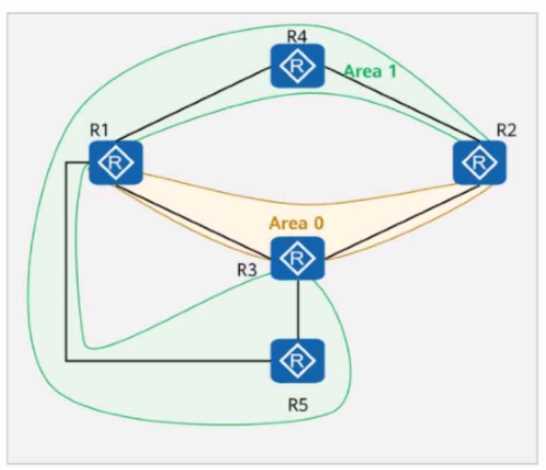
- A. The LSDBs of R1, R2, and R3 are the same.
- B. If R5 imports an external route, R4 does not need to rely on the Inter-Area-Router-LSA to calculate the external route.
- C. R1, R2, and R3 generate Inter-Area-Prefix-LSAs.
- D. The LSDBs of R4 and R5 are the same.
Answer:
C, D
Question 15
On the OSPFv3 network shown in the figure, area 1 is a stub area, area 2 is a common area, and area
3 is an NSS
- A. Router-LSA
- B. Link-LSA
- C. Intra-Area-Prefix-LSA
- D. AS-External-LSA
Answer:
D